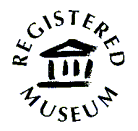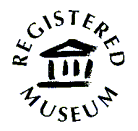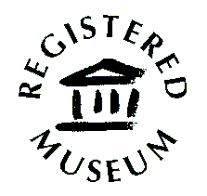

Newsletter
Issue 54 May 2006


~~~ NEWSDESK ~~~
Table of contents
Newsdesk, and dates for your diary 2
Merton Abbey Mills update 5
Hindu finds in the Thames 6
Canals 8
Museum Update 9
Spring Walk, Wandle Country Park 10
Glimpses of the Past - Beddington 13
John Williams 13
London lost trout river reborn 14
Newsdesk
Visits to the Museum We have been pleased to welcome several interesting visitors to the Museum recently. Firstly Meg and Jacquie were surprised to meet a relative of Lord Nelson taking an interest in our Nelson Display. He turned out to be the great-great-grandson of Nelson's youngest sister. He congratulated Meg on the information contained in the Exhibition.
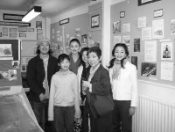
Our new friends from ‘Lee’ magazine, at the Museum
Secondly we were pleased to welcome Grant Ancell who was doing research into the history of Ansell Snuff Mills on the Wandle. He is a relative of the family now living in New Zealand, but at present staying in Tooting Bec.
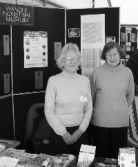
Volunteers Jacquie Tucker and Mavis Munt
Finally we were interested to meet Setsuo Nohara and her party representing a Japanese magazine called ‘Lee’. She was researching into Liberty prints and planning to publish a book about it. Mary Hart showed them artefacts from her own collection and from our archives. They were photographed for the Publication and a donation was given to the Museum for our services.
Volunteers The recent Volunteers' Quarterly Lunch Meeting was once again a great success. Jacquie Tucker is now firmly established as our new Volunteer Archivist with advice from Marguerite who comes in when her health allows. Eric Trim is now home from hospital with a wheelchair and his prosthetic legs. We hope to see him at our next lunch.
Eric Shaw and Meg Thomas are busy preparing our new Merton Priory Exhibition in June.
Outreach Thanks to the National Trust we were once again able to have our usual stall and display at Morden Hall Park Bank Holiday Fair A Country Affair. The new organisers did not cater for Charity Stalls, but we were offered a section of the National Trust marquee for a fee of £50 which solved our problems. The amount taken over the period was £310-49 which was an excellent result. Meg Thomas was due to mount a display stand, but was unable to, after suffering a severe back problem, but, thanks to Mary Hart, an alternative display was mounted just in time. It was a pleasure to showcase Lionel Green’s new book on Merton Priory, which we complemented with our own Merton Priory Timeline ‘freebie’. This was also the first outing of our ‘Why the Wandle Industrial Museum’ leaflet, sparked by the first question of the first visitor to the stand on the Saturday!. Thanks to the members and friends who helped over the weekend.
Future Events
* Opening of the new Merton Priory Exhibition Saturday 17th June at 11-00am. Invitations are included with this Newsletter. We do hope as many of you as possible will be able to attend. There will be wine and refreshments as usual and the new Mayor, Cllr Geraldine Stanford, will open the Exhibition.
* The Wandle Valley Festival is on the next day and the Museum will be open from 12.00-4.00pm. So if you can't get to the official opening, do come in on the Sunday or go and visit Mary and Auriel, who will be in the Chapter House at Merton Abbey Mills all day demonstrating block printing as one of the highlighted Festival events.
* The Wimbledon Village Fair is on Saturday June 24th all day from 10-00am when we shall be having our usual stall. Helpers required as usual.

* A Members' Visit has been arranged for Sunday July 16th to Carshalton Water Tower at 2-30pm. The Water Tower is set in the grounds of Carshalton House and was built in the 18th century to store and supply fresh water to the house. For this purpose it contained a water wheel which drove pumps to raise water from the lake in the grounds to the cistern in the top of the tower. It contains a suite of rooms including the Pump Chamber, the Orangery, the Saloon and the Bath Room with a plunge pool. All rooms can be visited and you can also climb to the roof of the Tower from which a grand view of Carshalton can be seen. Entrance to the Water Tower is 75p. It is entered from West Street (see map). Parking not available in West Street, but there is a car park off Carshalton High Street and in side roads. Refreshments are available at Honeywood Heritage Centre. Many buses stop at Carshalton Village. Members wishing to attend this visit please telephone Mary Hart on 020 8542 7534 and let her know if you might need transport.
Subscriptions There are still some members who have not yet paid their 2005-6 subscriptions. Prompt payment would be appreciated.
Sheila Harris May 2006
NEWSFLASH
In the last fortnight the news we have all been expecting finally became official. Youngs Brewery and the famous Brewery Tap (site of the old Ram Tavern) is to close, and the business relocated.
This is important to us at a number of levels, all selfish, but none the worse for that. Not the least of the concerns is the fear we will lose touch with John Young, Chairman of Young & Co, who has been a good friend to ourselves and the other Wandle related heritage enterprises for many years.
Loss of the famous drayhorses at local occasions, the fear of a loss in quality of our favourite local tipple, and the inevitable nostalgia for a building and industry which has been part of Wandle life for so long, all feature.
Purely at a museum level, we should not forget that the rear of the Youngs site was for many years a cloth dying mill (McGow 47 - Dye-works near High Street Bridge, Wandsworth ) until taken over by the brewery in 1868. It is likely that a site so close to the mouth of the Wandle, at one of its last crossing points, has a long history. Hopefully any planning permission for the site will ensure the appropriate archaeological review.
We have plenty of time to mount a proper appreciation of the brewery and its contribution to Wandle industry, but an era is ending, and we are entitled to be maudlin. Ed.
Merton Abbey Mills Update
The development is now complete, although the KFC repeated planning application for a drive through rumbles on.
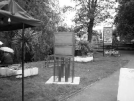
The new information stand
On the positive side, the commitment to improve the market was again demonstrated at this year’s May Fair in Morden Hall park, where a whole marquee was rented and paid for by the management to enable MAM stallholders to show their wares to a larger public, and, more importantly, to a swathe of possible new stallholders. We understand that this was a sufficient success to be repeated when Stage it, the event organisers, have a similar event at Hampton Court over the August Bank Holiday weekend.
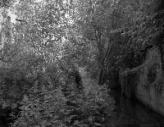
Bennets Ditch, verdant but unmanaged
A physical symbol of the new management has appeared in the last few days, with the erection of new information stand, said to be designed as a tribute to Charles Rennie Mackintosh, outside the Wheelhouse. Its siting looks clumsy, and interferes with one of the most picturesque views, but we shall see.
The Bennetts ditch landscaping has become lush and overgrown - temporarily creating a very attractive and unspoilt look, but clearly in need of urgent management if not to go too far.
Hindu Finds in the Wandle - Earlier this year, we were intrigued by reports from Merton Abbey Mills that their regular river cleaning exercises were throwing up what looked like Hindu religious offerings, and concern was being expressed at what looked like a potentially damaging intrusion on the Wandle’s delicate ecological balance, with some of the finds evidencing oils and the use of tinfoil to wrap the offerings.
However, quite by chance, the bargain box at our May Spring Fair stall produced an old copy of London Archaeologist, and there was an article by Nikola Burdon, then of the London Museum, on exactly this area. The illustration selected for reprint here shows the kind of pots being discovered in the Wandle, also.
With her kind permission, and that of both London Archaeologist and Museum of London, an extract is printed below. We are permitted to provide full copies of the article to anyone interested on a private or research basis.
Ed.
HINDU FINDS FROM THE THAMES
Nikola Burdon
(extracted from the longer article in London Archaeologist Autumn 2004. Our thanks to the author, to London Archaeologist and Museum of London for permission to reprint this article).
Archaeology is about using material culture (objects) to try and understand societies and cultures. We normally associate this study with the past, often the distant past, but it is of just as much relevance to modern culture. At the Museum of London we are particularly interested in how people and cultures have come together in the space we now call London, and how they have changed and utilised the landscape and been influenced by it. The Thames is now developing another facet by revealing elements of a culture embedded in today's diverse society. A range of objects that are associated with the practice of Hinduism, such as statuettes of deities and inscribed plaques, are currently being found on the Thames foreshore. What do these objects represent? Why were they put in the river? When were they put in the river? What should happen to the objects now? These are all important, yet difficult questions. The Museum is currently striving to find some answers through consultation with London's Hindu community.
What do the objects represent?
The most frequent finds are small clay lamps (Fig. 3). The lamps look almost Roman in their shape and fabric, and indeed, when the first example was brought into the Museum, it was initially identified as Roman. These lamps, which are filled with butter or ghee and then lit, tend to be associated with the festival of Diwali (Festival of Light). But they are used in many Hindu ceremonies and are considered to be a common object. There are also two complete clay pots (Fig. 3), which have been described to us as either water pots, for holding sanctified water containing drops from the Ganges, or as pots to hold cremations.
Why were they put in the river?
 Fig. 3: clay lamps used during
festivals such as Diwali and two
complete pots, possibly used as
water pots (Museum of
London)Figure 5
Fig. 3: clay lamps used during
festivals such as Diwali and two
complete pots, possibly used as
water pots (Museum of
London)Figure 5Flowing water plays a significant role in Hinduism and all rivers are seen as holy. The River Ganges is the most sacred river in India -she holds extreme powers and is an important place of pilgrimage. The river is deified as the Goddess Ganga, hence garlands and other offerings are thrown onto the surface of the water in the same way as offerings are made to honour an image in a temple. As the River Ganges is not very accessible to the Anglo-Hindu community, it could be that they are utilizing the next best thing - a river that has an impact on their lives and their surrounding landscape.
Some Hindu ceremonies have a specific element that involves water, such as Durga Puja, which culminates in a deity being deposited in flowing water. However, the larger than life deity is usually made of a dissolvable material. Another explanation is the deposition of damaged religious objects. A Hindu has a responsibility to dispose of damaged religious objects in a respectful way, by returning them to the earth. This is often done by submerging the object in running water that flows to the sea. But not all of the Hindu objects found on the foreshore are broken or damaged.
Whether the objects are a result of ceremonial activities or accidental loss is not entirely clear, although the growing number of objects is helping to discount the theory of purely accidental loss. If they have been deliberately deposited (as the objects are likely to have been owned by individuals), the reasons behind their deposition are probably very personal. There may not be one simple explanation, nor may all Hindus be necessarily aware of the individual practices within their community. Indeed, the Hindu priests and community leaders/members that we have consulted are surprised that these types of objects are being discovered.
When were they put in the River?
Although an almost impossible question to answer; what is significant is that we are finding them now. As mentioned above, the first objects of this type to be brought to the Museum were clay lamps, around ten years ago. In the past two or three years a steady trickle of objects associated with Hinduism have been brought to the Museum.
What should happen now?
The Museum of London has consulted a range of people from the Hindu community, all of whom have given their approval for the acquisition of the objects into the Museum's collections. They have also given their approval for the future display of the objects.
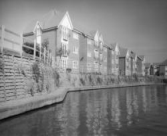
Flats on the Coventry Canal
Another aspect that should be noted here is the environmental impact of this practice. Is the deposition of objects into the Thames and other waterways polluting and harming the environment? Many of the Hindu organisations in London are keen to stress their awareness and commitment to a clean environment, and members of the community work together with agencies such as Thames 21 to help clean up the Thames and other waterways.
Nikola Burdon
Canals, Part 2
(photos by Meg Thomas 2005)
In 1946 Tom and Angela Rolt met Robert Aickman at Tardebigge, on the Worster and Birmingham canal.
Being canal enthusiasts they decided to found the Inland Waterways Association to regenerate the waterways, and spread their enjoyment of the canals. You only need to see how many companies now offer canal holidays to appreciate their success. As is so often the case a huge part of our industrial history was only preserved due to the perseverance of a handful of devoted enthusiasts.
While travelling along the canals I was pleased to see how many of the local councils have become aware of the recreational and developmental possibilities of the canals. This includes businesses as well, Wedgewood and Cadburys welcome canal travellers to their visitor centres along the canals.The canals which were so essential to their trade in the past.
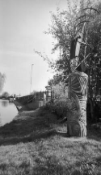
‘The Journeyman’
The Gas Street Basin in Birmingham now has a new lease of life. Office blocks have been built but there are also restaurants and leisure areas, it was certainly pleasanter boating through Birmingham than contending with the road traffic.
There are houses along the canal banks some have been there for many years, but there is also much new building. The photograph shows flats along the Coventry canal. I have included some photos of the Canal Art Work that caught my eye as we continued along the Coventry canal.
Some reflect the history of the canals as in the sculpture, Journey Man, showing the tools used by the navvies to dig the canals, and some are more modern like the Fish railings near a children's play area and the bridge 'Swans over the water'.
The vision of the Rolts and Robert Aickman have not only kept alive part of our industrial history but has ensured the continued care of the canals as the canals are now part of a thriving holiday business.
Museum Update - Meg Thomas writes:
In the last 18 months, since taking on curatorial responsibilities for the Museum, I have discovered a whole new world of committees. All with their own set of initials - ALM, MLA, WLMG, the HUB, LMG and, believe, me many more.
Some of these organisations run useful courses, and in the case of the ALM these are often free, good for small museums. Some meetings are rather full of 'committee speak' and I am sometimes blinded by the amounts of money these committees are being given by the Government, but finding out exactly how small museums will benefit has proved rather difficult. I'm sure this comes as a great surprise to you all.
I must add that these meetings do have their perks. I meet people from many museums, big and small, and they meet me so our name is heard out there. The venues for these meetings are often in interesting museums or behind the scenes in the larger museums and the lunches are usually very tasty.
This has been, for me, an introduction to a whole new museum world!
I am very busy now preparing the Merton Priory display to be ready for the opening on 17 June, with the help of Eric Shaw, recycler 'par excellence' ( though I do sometimes let him buy new materials). When this display is finished we will have refurbished all the displays.
Eric has put a permanent museum sign over the door, maybe this will mean we won't hear the comment 'I didn't Know you were here' any more.
A Spring Walk to mark the proposed Wandle Valley Country Park
A walk in the spring sunshine from Mitcham Common to Beddington Park in Sutton was a great success. Being a bit of a day-facto walking enthusiast, I was pleased to have the chance to attend this spring walk from Mitcham to Beddington on March 26.
This event was arranged to help promote what should hopefully become the Wandle Valley Country
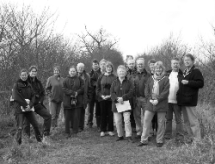
Group photo, with the two Mayors.
Park. This was part of an ongoing series of activities that reflect the diversity of the community while leveraging environmental awareness to demonstrate the potential for this restoration scheme with funding from the Sustainable and Accessible Urban Landscape programme.
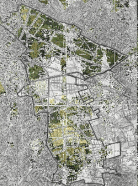
Groundwork’s outline of the proposed park overlaid on a satellite photo
The current planning proposal, if approved, would see completion of the new sub-regional public park by 2023 which would cover approximately 500 hectares of open land from Mitcham Common, through Beddington Farmlands and Beddington Park. The area would be linked to the Wandle Trail and to the London Cycle Network. Currently the common in the north, and the park in the south, are marooned either side of the industrial ‘farmlands’ area, with a single designated footpath linking the two.
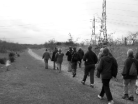
The path beside Beddington Farm which is all that currently links the Mitcham and Beddington sections
Fortunately since 1980 permits are required for gravel extraction (due to concerns that gravel mining may be adversely affecting the park and its wildlife) and this has meant that conditions could be imposed on the current gravel extraction in Beddington Farmlands that will require the contractor to return the site to an ecologically sound one by the time the license terminates in 2023. This will enable the new park is to incorporate ‘natural’ landscaping improvements similar to those associated with the landfill and gravel extraction operations and the additional hills created from the old tip sites found in the Common. These and the other past commercial operations would be repaired, ecological importance would be conserved, recreational facilities added and archaeological features would be enhanced in the area.
The Spring Walk was organised by Groundwork in conjunction with the two boroughs to help sustain interest in the project, following the launch of the DVD to schools. We and others, including walkers from local heritage groups, met at the bridge overlooking Mitcham Junction Train Station. The guests were joined by several local dignitaries who helped welcome us, including the Mayor of Merton, Councillor Judy Saunders along with the Mitcham Common Conservators and the Deputy Mayor of Sutton, Cllr Richard Bailey, symbolising the co-operation of the two councils in this project.
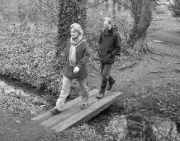
Cllr Judy Saunders striding across one of the Beddington Park channels.
After a quick overture and photo opportunity, just off the bridge, we started off towards Carshalton passing through the woodland and scrub of the common, we came upon an area once occupied by anti-aircraft emplacements now unsurprisingly referred to as the ‘gun site’. The last traces of the batteries and billets of the troops are now largely restored to a natural state, with much interesting ecology.
We then crossed the railway line, and, leaving the golf course on our left, took the new footpath along side Beddington Farm (previously Beddington Marsh - see Glimpse of the Past, below) which already incorporates a wildlife haven and a major wild fowl reserve alongside the gravel extraction works where the RSPB volunteers are doing good work in building a sustainable habitat, and looking to reintroduce some of the birdlife previously lost to this area.
At the end of this track, we emerged onto Beddington Park, a much more artificial area, but with an interesting diversity of planting. From the museum’s point of view, there is a greater interest, because the Wandle enters the park here, and the many channels which still exist show man’s interference with its natural course, and evidence the industrial history of this part of the trail, although the mill buildings are long gone (McGow 6- Wallington Paper Mill).
We finished at the pavilion at the end of Church Road, and were provided with complementary hot drinks and beverages. All in all a good and interesting walk, and we look forward to repeating it over the years to keep an eye on the concept as it develops and improves.
Michael Hart, Spring 2006
Glimpse of the Past - Beddington,
from 'the Carews of Beddington' by R. Michell.
With thanks to Marguerite Lee Delisle
Beddington lies almost exactly nine miles due south of Westminster. The name is practically unknown, except to those who live there. In 1937 it was swallowed whole by its one-time hamlet of Wallington and thirty-two years later Wallington itself was merged into the London Borough of Sutton. But it is a green place still, that has not yet shaken off its history. The best vantage point is the ridge where Queen Elizabeth I is said to have walked. Here, in a grove, depleted, but not denuded, now that the elms have gone, one can look towards the north and see only meadows, treetops and the grey tower of St. Mary's Church. In the foreground, traffic on the busy Croydon Road is out of sight, and almost out of sound, in the deep and ancient cutting through which it winds up towards the old village centre. The monstrous cooling towers of Croydon power station are hidden by the avenues of giant beeches and chestnuts that lead the eye across what was the Tudor deer-park. Beyond the park, Beddington Marsh stretches, as yet, free of bricks and mortar to the edges of Mitcham Common. The river Wandle makes its first appearance just outside Beddington and meanders through the park towards the lake that was once the mill-pond for Wallington Mill. Just beyond the church, looking redbrick and rather Victorian, which indeed it is on the outside, is the Manor House that replaces the one leased by young Nicholas Carew in 1353. If the description sounds idyllic, one has to confess that everything else is houses. Sixty years ago topographers waxed lyrical about the trees, ancient timber-frame buildings, and eighteenth century mansions that made up the village centre. All have now gone save for one much misused mansion. After the First World War the houses crumbled and their estates were sold off to the speculative builders. The fields are still giving place to the housing needs of London.
The late John Williams
Local History Records, volume 46, Feb 2006, The Bourne Society
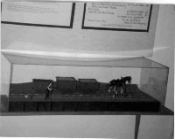
Surrey Iron Railway model at East Surrey Museum
There is an obituary of John Williams in the above journal. In it is mentioned that one of his interests was the Surrey Iron Railway. It is of interest to the Wandle Industrial Museum because when we were located at Hartfield Crescent Wimbledon we had on display a model of wagons on the Surrey Iron Railway made by John Williams. Unfortunately it was smoke damaged when the fire occurred at Hartfield Crescent. Subsequently a model appeared at the East Surrey Museum of which he was a steward and a member of the Friends group.
In Peter McGow's account of the Railway, November 2001, he also mentions that the model is on display at the East Surrey Museum. Recently (3rd March 2006) I had visited that museum to see if the model was still on display, but nobody in attendance knew anything about it.
However Roger Packham who wrote the obituary seemed to remember the model and after making enquiries on my behalf found that the model is in store at the Museum and can be viewed by prior arrangement.
Eric Shaw March 2006
London's Lost Trout River Reborn
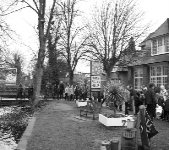
Schoolchildren arriving at Merton Abbey Mills to release their trout fry
The river Wandle once offered wonderful trout fishing, up to the latter part of the last century it was prized by anglers including, some say, Lord Nelson who fished here two centuries ago, before annihilating Napoleon's fleet at the battle of Trafalgar.
The rivers swift flows were increasingly harnessed to power water mills producing everything from silk to gunpowder, but also to take away the effluent, and, by the 20th century the river was all but dead!
Now, after centuries of abuse and neglect, and the indignity of running red, pink & blue from the dyes of the calico printers, and worse, we are learning to treasure the Wandle. As a result, the kingfishers, water voles and mayflies have returned.
In the 1960s the Wandle was officially designated an open sewer. A major factor in its recovery since then can be traced back to the privatisation of Britain's water industry. In our area Thames Water has invested millions of pounds into improving water quality.
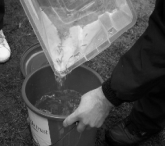
The photo here shows trout fry being transferred from their carrying container into a bucket preparatory to their release.
In March 2003 brown trout were released into the Wandle for first time in 100 years, thanks to Alan Suttie’s ‘Trout in the Classroom’ program, which is run by the Jet Set Club in partnership with Environment Agency and Thames Water. This is a relatively simple idea where teachers set up aquariums and incubate trout eggs in their classrooms. The teachers and children are responsible for daily maintenance and observation of these eggs until they have an aquarium full of trout fry, which is released into the Wandle during a class field trip.
The project is designed specifically to incorporate more environmental education into the curriculum by inviting local Primary Schools to breed trout in the classroom and releasing them into the River Wandle thus helping to sustain the river’s population of brown trout.
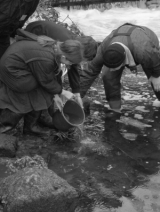
Free at last!
Although only two of every hundred are likely to survive into adulthood, this is a cumulative process and we are hoping that each such release exponentially increases the benefits.
March 27th saw 4 local primary schools and Linden Lodge special school visit Merton Abbey Mills to release this year’s trout fry into the Wandle, in the presence of various local dignitaries including Merton’s Deputy Mayor and his wife, and the Leader of the Council. A parallel event involving Wandsworth schools took place a few days later.
Michael Hart May 06
The Vestry Hall Annexe, London Road, Mitcham, Surrey CR4 3UD
Tel: 020-8648-0127
~~~~~~~~~~
OPEN: Every Wednesday 1 ~ 4 pm;
First Sunday of each month 2 ~ 5 pm.
~~~~~~~~~~
The Museum is also open to schools and groups by appointment.
~~~~~~~~~~
Admission: Adults 50p, Children & Senior Citizens 20p
The Wandle Industrial Museum would like to point out that the views of contributors to this newsletter are not necessarily the views of the Museum. We would be happy to give the right to reply to anyone who finds the content contentious.
